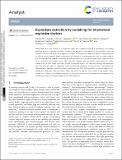Files in this item
Explosives detection by swabbing for improvised explosive devices
Item metadata
| dc.contributor.author | Glackin, James Michael Edward | |
| dc.contributor.author | Gillanders, Ross Neil | |
| dc.contributor.author | Eriksson, Frans | |
| dc.contributor.author | Fjällgren, Marcus | |
| dc.contributor.author | Engblom, Joachim | |
| dc.contributor.author | Mohammed, Salam | |
| dc.contributor.author | Samuel, Ifor David William | |
| dc.contributor.author | Turnbull, Graham | |
| dc.date.accessioned | 2020-10-19T10:30:03Z | |
| dc.date.available | 2020-10-19T10:30:03Z | |
| dc.date.issued | 2020-10-05 | |
| dc.identifier | 270555358 | |
| dc.identifier | e4746195-fa13-4704-85b2-39243c29980a | |
| dc.identifier | 000607343400018 | |
| dc.identifier | 85099120719 | |
| dc.identifier.citation | Glackin , J M E , Gillanders , R N , Eriksson , F , Fjällgren , M , Engblom , J , Mohammed , S , Samuel , I D W & Turnbull , G 2020 , ' Explosives detection by swabbing for improvised explosive devices ' , Analyst . https://doi.org/10.1039/D0AN01312A | en |
| dc.identifier.issn | 0003-2654 | |
| dc.identifier.other | ORCID: /0000-0002-8825-3234/work/81797768 | |
| dc.identifier.uri | https://hdl.handle.net/10023/20799 | |
| dc.description | Funding: The authors acknowledge funding from the EPSRC DTG (EP/L505079/1) and EPSRC (EP/N509759/1). | en |
| dc.description.abstract | Swabs taken from the surface of a suspicious object are a standard method of identifying a concealed explosive device in security-conscious locations like airports. In this paper we demonstrate a sensitive method to collect and detect trace explosive residues from improvised explosive devices using swabs and an optical sensor element. Swabs coated with a commercial fluoropolymer are used to collect material and are subsequently heated to thermally desorb the explosives, causing the quenching of light emission from a thin film luminescent sensor. We report the sorption and desorption characteristics of swabs loaded with 2,4-DNT tested with Super Yellow fluorescence sensors in a laboratory setting, with detection that is up to three orders of magnitude more sensitive than standard colorimetric tests. The method was then applied in field tests with raw military-grade explosives TNT, PETN and RDX, on various objects containing the explosives, and post-blast craters. We show for the first time results using organic semiconductors to detect sub-milligram amounts of explosive sorbed onto a substrate from real explosives in the field, giving a promising new approach for IED detection. | |
| dc.format.extent | 8 | |
| dc.format.extent | 2547625 | |
| dc.language.iso | eng | |
| dc.relation.ispartof | Analyst | en |
| dc.subject | Nitroaromatic | en |
| dc.subject | Organic semiconductor | en |
| dc.subject | Luminescence quenching | en |
| dc.subject | Fluoropolymer | en |
| dc.subject | Optical sensing | en |
| dc.subject | Super Yellow | en |
| dc.subject | QC Physics | en |
| dc.subject | QD Chemistry | en |
| dc.subject | DAS | en |
| dc.subject.lcc | QC | en |
| dc.subject.lcc | QD | en |
| dc.title | Explosives detection by swabbing for improvised explosive devices | en |
| dc.type | Journal article | en |
| dc.contributor.sponsor | EPSRC | en |
| dc.contributor.institution | University of St Andrews. School of Physics and Astronomy | en |
| dc.contributor.institution | University of St Andrews. Centre for Biophotonics | en |
| dc.contributor.institution | University of St Andrews. Condensed Matter Physics | en |
| dc.contributor.institution | University of St Andrews. Sir James Mackenzie Institute for Early Diagnosis | en |
| dc.identifier.doi | https://doi.org/10.1039/D0AN01312A | |
| dc.description.status | Peer reviewed | en |
| dc.identifier.grantnumber | EP/R511778/1 | en |
This item appears in the following Collection(s)
Items in the St Andrews Research Repository are protected by copyright, with all rights reserved, unless otherwise indicated.

